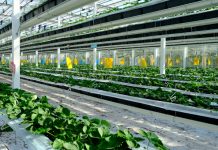
Geometry Healthcare, a Beijing-based manufacturer of intelligent health monitoring products, has focused on producing self-developed intelligent toilets that can monitor users’ health. The company is already cooperating with domestic home furnishing brands and nursing homes, and seeks to export its products in the third quarter this year. Many foreign businesses are reaching out to the manufacturer in the hopes of collaborating.
China’s progress is not limited to the manufacturing of consumer goods. It has also made world-leading achievements in cutting-edge fields including aerospace, biotechnology, quantum computing, 5G and high-speed trains, and is catching up in chipmaking, new materials and integrated circuits.
Data from the Ministry of Science and Technology (MOST) showed that 169 state-level hi-tech zones contributed about 13 percent of China’s GDP in 2021, using only 0.1 percent of its land area. Its spending on research and development (R&D) rose 14.2 percent year on year to 2.79 trillion yuan ($441.66 billion) last year, a record 2.44 percent of GDP.
Higher end
China has been promoting the use of new technologies in its pursuit of high-quality development, moving up on global value chains.
In 2021, it launched the crewed spaceships Shenzhou-12 and Shenzhou-13, opened the world’s largest radio telescope, and saw progress in quantum computing systems as well as the making of 28- and 14-nm chips. Innovative solutions based on technologies such as big data, artificial intelligence (AI), virtual reality (VR), 5G and the Internet of Things (IoT) also emerged.
Automated robots, for example, have been applied in fields including logistics, auto manufacturing, food delivery, household services and epidemic containment. Drones for agriculture, weather monitoring and power system inspection have also seen broader use.
Estun Automation in Nanjing, Jiangsu Province, is a manufacturer of automation equipment for lithium, photovoltaic and welding industries. Around 80 percent of the core components used in the company’s robots are self-developed. To improve international competitiveness, it has established an R&D center in Europe and is recruiting international teams.
New technologies too, have empowered traditional manufacturing industries. Lenovo Group, one of the world’s largest PC makers, has established an automated assembly line based on 5G and IoT technologies at its Wuhan plant in Hubei Province. According to the company, the automated robots it uses are capable of delivering approximately 13,000 individual parts in 90 minutes, improving efficiency by 20 percent.
“Cheap labor forces will no longer be China’s advantage. Technological progress has lowered the costs of automated machines, further improving the potential of intelligent manufacturing,” Chen Baoming, a researcher with the Science and Technology Talents Center of MOST, told Beijing Review.
According to the Ministry of Industry and Information Technology (MIIT), the revenue of China’s robotics industry exceeded 100 billion yuan ($15.7 billion) for the first time in 2020, with output reaching 212,000.
Data from the National Bureau of Statistics (NBS) also showed output of the industrial robot manufacturing sector jumped 29.6 percent year on year in the first two months of this year.
In December 2021, the MIIT issued development plans for the robotics industry and intelligent manufacturing sector during the 14th Five-Year Plan (2021-25) period. One of the priorities is to further expand the use of robots in medical care, electricity supply, mining, agriculture and manufacturing industries to supplement the work of human workers. It also pledged to achieve breakthroughs in core technologies and high-end products by 2025.
To provide digital backup for its industrial transformation, China has been rolling out digital infrastructure, ranging from 5G base stations to big data centers. In February, the authorities approved a project involving the development of eight national computing hubs and plans to build 10 national data center clusters to channel more computing resources from the eastern provinces to the less developed yet resource-rich western region.
“Basic research and the digital economy are imperative to driving technological innovation. Only by addressing technological monopolies and boosting the digital economy can China ensure sound economic growth and consolidate the resilience of supply and industrial chains,” Pan Helin, Executive Director of the Digital Economy Academy at Zhongnan University of Economics and Law in Wuhan, told Beijing Review.
The good life
Technological leaps have helped improve the wellbeing of Chinese people, bringing both convenience and comfort. A greater number of homegrown new-energy vehicle (NEV), smart home appliance and electronic device manufacturers have risen from obscurity to fame.
Beijing Know Smart Technology Co. Ltd. has been developing products based on AI and IoT, including robot coffee baristas and smart home systems. As China’s population is aging, the company aims to make its products as simple and convenient to use as possible, capable of meeting the needs of all age groups.
Based on big data, online platforms offering goods and services have grown rapidly, especially during the pandemic. The digital yuan, the digital version of China’s currency, has also been piloted in more scenarios to ride the tide of the digital era.
New technologies are also making cities smarter. Baidu has launched AI systems to improve traffic on some roads in Baoding, Hebei Province, helping reduce the time needed to cross the intersections by 20 percent. VR has been more widely applied in property marketing, exhibitions and entertainment programs.
Agricultural technology and biotechnology are developing to meet both basic and upgraded demands. Experts have been developing new crop varieties and cattle breeds with higher yield and quality, with the aim to increase China’s self-reliance in food security. Against the COVID-19 pandemic and other diseases, domestic pharmaceutical researchers and enterprises have been committed to developing and producing drugs, medical facilities and vaccines.
Zhongguancun Life Science Park is a biotechnology hub in Beijing that has gathered nearly 500 pharmaceutical and healthcare companies. According to the park’s management, many of its enterprises have contributed to the development of COVID-19 test kits, vaccines and drugs.
“Test kits produced by Beijing Applied Biological Technologies Co. Ltd., a molecular diagnostic enterprise, have hit the market. Beijing Singlomics Co. Ltd., together with a team from Peking University, developed a neutralizing antibody treatment for COVID-19, which was authorized for compassionate use in a Beijing hospital last year,” Yang Weiwei, an official with the park, told Beijing Review.
Guangzhou Saliai Stem Cell Science and Technology Co. Ltd., based in Guangdong Province, focuses on using stem cells to develop drugs and cosmetics. In response to growing market demand, it is leveraging opportunities and resources from Guangdong and neighboring Hong Kong and Macao special administrative regions, to develop a range of high-quality skincare products.
“Technological innovation has improved the international competitiveness of Chinese products and services. That will drive a great leap of its real economy,” Ni Guangnan, an academic at the Chinese Academy of Engineering, told People’s Daily Online.
Green goals
China’s goals of peaking carbon emissions before 2030 and achieving carbon neutrality before 2060 have driven technological innovation in green development. It is working on promoting green transportation and expanding the use of renewable energy including wind, hydro, photovoltaic (PV) and hydrogen power in industrial production.
In the first two months of this year, NEV sales logged a year-on-year increase of 150.5 percent, while that of solar batteries jumped 26.4 percent year on year, the NBS said. NEV startups have boomed in China in recent years as consumption and charging infrastructure continue to improve.
During the Olympic Winter Games Beijing 2022, hydrogen was used as fuel for both the Olympic torch and transportation. According to the Beijing 2022 organizing committee, around 1,000 hydrogen-fueled buses and over 30 hydrogen stations were operational during the Games. Hydrogen fuel cell buses can withstand low temperatures, and only emit pure water as a byproduct of energy consumption, resulting in less pollution than fossil-fuel-powered vehicles.
The National Alliance of Hydrogen and Fuel Cells said China’s demand for hydrogen energy will reach 60 million tons by 2050, which is expected to help reduce carbon emissions by 700 million tons.
Wind and PV power have boosted green industrial growth, especially in rural areas. Data released by the National Energy Administration indicated that the installed capacity of wind power jumped 17.5 percent year on year to reach 330 million kW in the January-February period of this year. In 2021 alone, China added 52.97 million kW of installed PV power generation capacity, about 55 percent of which was contributed by systems like rooftop PV panels, which have been launched in many rural areas.
Wu Gang, Chairman of wind turbine manufacturer Xinjiang Goldwind Science and Technology Co. Ltd., told Beijing Review that, as the world’s largest energy consumer, China must hasten its shift to green power.
Since the country is in the initial stages of its energy transformation, boosting wind power, a common type of renewable energy, is vital to driving the transition. Whereas homegrown core technologies have increasingly matured, sustainably generating economic benefits, wind power’s substantial potential in empowering rural revitalization has yet to be unleashed.
“The government needs to promote the development of wind power demonstration counties, townships and villages to energize rural areas. With immense potential, these areas can translate their wind resources into profits while meeting their own electricity demands at a low cost,” Wu said.
Fill in the gap
As a late starter in the hi-tech arena, China has not achieved 100 percent self-reliance in many core technologies. According to Chen, the rise of raw material prices, chip shortages and supply chain breakdowns caused by the pandemic have posed challenges to domestic enterprises, especially manufacturing and tech firms. To cope with these, they need to improve raw material inventory, diversify supply sources, and seek to fill in the gap of cutting-edge technologies.
The authorities need to introduce inclusive policies to encourage enterprises to engage in more R&D, boost cooperation between universities, enterprises and research institutes, and encourage enterprises to focus on niche fields for distinctive competitiveness, Chen said.
Encouragingly, the government has announced to enhance its policy on making R&D costs tax-deductible by raising the deduction coverage for small and medium-sized sci-tech enterprises from 75 percent to 100 percent. It also pledged to increase basic research funding, and improve the protection of intellectual property rights.
Chen also suggested giving full play to China’s late-mover advantages in the digital economy. “Facing the integration of the digital and real economies in recent years, businesses should accelerate their embrace of digital transformation. The government needs to encourage the development of digital service providers, and improve digital infrastructure and laws and regulations to drive digitization,” he concluded. -The Daily Mail-Beijing Review News Exchange Item





